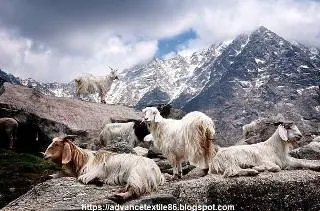Cashmere wool
Cashmere
wool is a fiber derived from Cashmere goats, pashmina goats, and some other
breeds of goats. It has been used in the manufacture of yarn, textiles, and
clothing for hundreds of years. Both soft undercoats and guard hair can be used
such as soft hair is reserved for textiles, while thick guard hair is used for
brushing and other non-garment purposes.
Cashmere
wool fiber is used for garments and other textile materials are obtained from
the neck region of Cashmere. The Cashmere goat forms a double fleece called
guard hair, consisting of a straight, mixed with a fine, soft undercoat or
Underdown hair, and a much thicker outer layer of hair. For fine Underdown
sales and further processing, it must be de-haired. This de-hairing is a mechanical
process that separates coarse hair from fine hair. After de-hairing, the
resulting cashmere is ready to be dyed and transformed into textile yarn,
cloth, and garment.
Pure
cashmere can be dyed and spun with yarn and knitted into jumpers/sweaters,
hats, gloves, socks, and other garments, or woven into fabrics then cut and
combined into garments like outer coats, jackets, trousers, pajamas, scarves,
blankets, and other items. Clothing and apparel manufacturers in Scotland,
Italy, and Japan have long been known as market leaders. Cashmere wool can be
blended with other fibers to reduce the cost of clothing, or to give elasticity
or luster to silk from their properties.
Cashmere wool history
Cashmere
wool has been created in Mongolia, Nepal, and Kashmir for thousands of years.
The fiber is also known as pashm or pashmina for use in handmade shawls of
Kashmir. Commercial trade in raw cashmere between Asia and Europe began with
Valerie Adreset SA, Louviers, France, claiming to be the first European company
to spin cashmere commercially. The down was imported from Tibet through Kazan,
the capital of the Russian province of Volga, and was used in France to make
imitation shawls. The imported cashmere was spread in a large sieve and beaten
with sticks to open the fiber and clean the dirt. After opening, the cashmere
was washed and the children removed their thick hair. The down was then carded
and combed using the same method used for bad spinning. Shawls were introduced
in Western Europe when General Napoleon Bonaparte sent one of his expeditions
from Ottoman Egypt to Paris. The arrival of the shawl was reported to have
created an immediate sensation and the product was planned to start production
in France. By the 1830s, cashmere shawl weaving with French-produced yarn had
become an important Scottish industry. Henry Holdsworth and his sons began
making yarn in 1832 and received the prize in 1833. Dawson International claims
to have invented the first commercial dehairing machine in 1890 and has been
buying cashmere from China since 1906 but was limited to buying fiber from
Beijing and Tianjin until 1978. Trade was liberalized in 1978 and Dawson
International began buying cashmere from many provinces.
Fiber description
Cashmere
goats have a protective outer covering of 4 to 20 cm thick fiber in length. The
downy undercoat is made up of fine, soft fibers commonly called cashmere that
is 2.5 to 9 cm long. Most of these down fibers are plucked or combed by hand
during the melting season. Iranian cashmere is obtained by shearing. The annual
yield per animal ranges from a few grams to about 0.5 kilograms. A sweater
requires 4 to 6 goat fleece. Some fibers are called tanned cashmere which is
taken from the skin of slaughtered animals.
Fiber processing
Fleece
is cleaned to remove impurities such as grease and vegetable matter. Thick
hairs are removed by various mechanical dehiring processes that are often kept
secret by their developers. Processing reduces the final yield by about 50
percent. The amount of rest of thick hair greatly influences the price,
with fiber leading to the highest price with the lowest hair content.
High-quality cashmere-coated fabrics usually contain less than 5 percent of
thick hair; Fine quality sweaters contain less than 1 percent. The outer layers
of fine fibers or the fibers that make up the epidermis are less distinct than
fur, although more pronounced than mohair; the cortical layer is straightened
and contains a variety of pigments that make up the fiber color and have no
distinct medulla. The diameter of the fibers is finer than the best wool.
Cashmere wool qualities
The
fabric made of cashmere is warm and comfortable for the wearer and has
excellent dropping qualities and soft texture. Fiber, which absorbs and retains
moisture much like wool, is slightly weaker than fine wool and significantly
weaker than mohair. It is highly susceptible to damage by strong alkalis and
high temperatures. Darker fibers are bleached to get a lighter shade, although
the process can reduce strength and softness. Wearing cashmere clothes subject
to abrasion such as pilling, or assembling surface fibers, is a problem with
knitwear.
Cashmere wool applications
i. Cashmere is mainly used for fine coats, dresses, and suits, and
high-quality knitwear and hosiery.
ii. It is sometimes mixed with other fibers.
iii. Tough, thick hair separated from the bottom is used locally for
grain bags, ropes, blankets, and tent curtains.










0 Comments